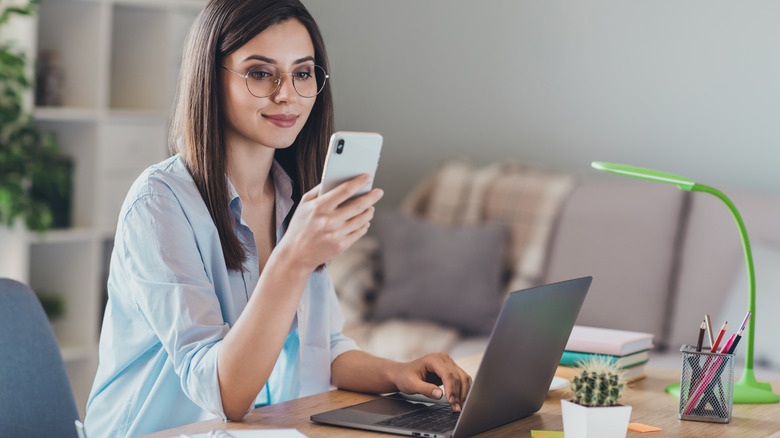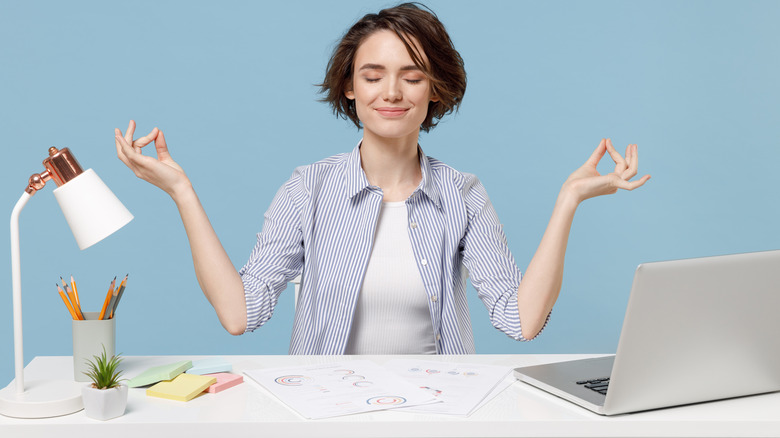Which Colors Will Improve Or Hinder Workflow?
Remote working: It started off as a temporary solution to the pandemic and has now turned into the way of the future. For some, the ability to work in the comfort of their own home sounds like a more relaxing alternative to what can be an otherwise stressful office environment (per Chicago Booth Review). For others, though, working from home may be affecting their productivity and concentration. If you find yourself in the latter category, then it might be time to refresh your home office set-up.
One major way you can change things up in your work area is to incorporate mood-boosting colors, per LinkedIn. Most major corporations hire psychologists and color experts when designing and decorating an office building to ensure they use the best colors to match the company's mission. When designing your workspace, it's important to consider your role at the company and the functions the job entails.
It's also important to factor in your individual personality and your tendencies, like whether you stay calm and collected, get dull and drowsy, or you're hyperactive and anxious. Once you know what feelings you want the colors in your home office to evoke, there are a few general guidelines to follow surrounding the psychology of color in the workplace.
Colors that improve productivity
The key to boosting the energy in your work area is to embrace color. Forbes recommends blue and green as the best colors to incorporate in your office. Blue is one of the most highly recommended colors to incorporate as it induces a calming effect, which can help ease anxiety and provide focus for detail-oriented projects (via LinkedIn).
According to Redbooth, blue is an especially helpful color in positions that require high degrees of intelligence, as well as administrative roles that require intense concentration. Painting an accent wall with your favorite shade of blue is a great way to bring a positive aura into your workspace.
Although not a primary color, green is another color that comes highly recommended to include at work. Green is easy on the eyes, and can bring a sense of reassurance and relaxation to help keep your mind balanced and ready to take on all the day's tasks. For those who love to meditate and/or do yoga before work, green will help keep the good vibes as you ease into the work day.
Per LinkedIn, light green can especially soothe anxiety. Incorporating houseplants or even fake plants, if you don't have a green thumb, can help create a sense of peace and zen as you work your 9-to-5. If you work in a creative role or are an entrepreneur, yellow is your go-to color. This color boosts optimism and sparks creativity. Adding yellow furniture can help energize and stimulate your mind.
Colors you may want to avoid in your workspace
While yellow can help ignite innovative, fresh ideas, it should also be used sparingly. Too much of the color, or too bright of a yellow, can induce stress and cause your brain to go into overdrive (per Painter1). Red is also a color that should be used with caution. It's a color that increases the heart rate and stimulates blood flow, which can boost energy levels.
Red can be especially helpful in jobs that require intense physical labor, though, and is often used in construction workplaces and restaurants. However, it's not one that is recommended for an office setting as it can leave you feeling overwhelmed and even prone to anger. Psychologist Lee Chambers told Homes and Gardens that painting a home office red can also increase the "potential for mistakes or conflict."
Neutrals may seem like a safe option for a workspace, but they can also come across as dull and gloomy. LinkedIn says white is the worst paint color for an office as it can feel like you're in a hospital. Stark white can also create a cold, lonely environment. That's why Painter 1 recommends a warmer off-white like cream or eggshell.
According to Entrepreneur, less saturated colors like beige and gray can especially cause feelings of depression in women. Calibre Furniture also warns against using black and charcoal, as the dark neutrals can cause the office to feel intense and morose. Looks like color can really make all the difference!


